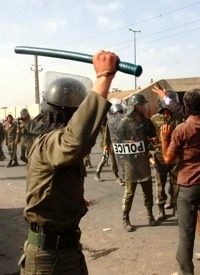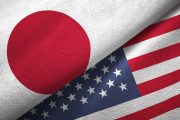
Hundreds of mourners gathered at Tehran’s Behesht-e Zahra cemetery on July 27 to honor those killed in the unrest that followed the June 12 re-election of President Mahmoud Ahmadinejad.
VOA News cited witnesses who said that riot police surrounded reformist opposition leader Mir Hossein Mousavi, forcing him back into his car and out of the cemetery. Mousavi was Ahmadinejad’s leading opponent in the election and received 33 percent of the votes cast.
The timing of the memorial coincided with the 40th day since the death of Neda Agha Soltan, the 26-year-old music student who became a symbol for opposition demonstrators after an Internet video showed her death after being shot during a post-election protest in Tehran. It is a tradition among Shia Muslims to mark 40 days after a death with a ceremony called the "arbayeen."
Some of the mourners gathered for the ceremony chanted: "Neda is alive, Ahmadinejad is dead!"
BBC News reported that Mousavi and another opposition leader, Mehdi Karroubi, had asked the Interior Ministry for permission to hold a memorial service in the Grand Mossala prayer area, saying that the gathering would "be held without any speeches and will be limited to the reciting of the Quran and moments of silence." But an aide to Mousavi said that permission had been denied.
AP reported that Interior Ministry official Mahmoud Abbaszadeh Meshkini was quoted by the state IRNA news agency as saying on July 26 that the ministry has not issued "any permission for any gathering."
"So far, it’s unprecedented that someone asks permission for a memorial service from the Interior Ministry," Meshkini said, adding sarcastically (according to sources): "Unless the applicant has other particular political intentions."
Karroubi attempted to give a speech at the memorial gathering, but police charged into his audience, preventing him from continuing. The police at times fired tear gas and beat protesters with batons to disperse the crowds.
The British Guardian newspaper reported that both Mousavi and Karoubi had been invited by Neda’s mother, Hajar, to mark the end of the 40-day mourning period for her daughter.
Fox News reported that before the clashes, police arrested two prominent Iranian filmmakers who tried to lay flowers at Soltan’s grave. One, Jafar Panahi, is best known for his film The Circle, which was banned in Iran for its critical view of the treatment of women under the Islamist government. A female documentary producer, Mahnaz Mohammadi, was arrested with him.
According to the Guardian, several senior clerics have condemned the crackdown on protestors, including outspoken dissident cleric Ayatollah Hossein-Ali Montazeri. Montazeri was highly critical of an order issued this week by the supreme leader, Ayatollah Ali Khamenei, to close Kahrizak prison, where at least one detainee was killed. "Can the government deceive people by closing a detention centre and blaming all the faults on a building?" he asked. "What benefit does the government gain from the crisis, except angering the majority of the people and weakening the Islamic republic?"
Montazeri has demanded the prosecution of those officials responsible for abuses. Montazeri is one of the most senior public officials in Iran and was one of the leaders of the Iranian Revolution in 1979. He was once considered to be the designated successor to the revolution’s Supreme Leader Ayatollah Khomeini. Interestingly, his onetime rival for leadership in Iran, Akbar Hashemi Rafsanjani, was a fierce critic of Ahmadinejad during the election and has also voiced guarded criticism of the government’s post-election crackdown.
In a statement made by Montazeri on July 26, he compared the current protests against Ahmadinejad’s election to dissent against the government of Iran’s former ruler, Shah Mohammad Reza Pahlavi. Montazeri had been imprisoned during the Shah’s rule in 1974 but was released in 1978 in time to be active during the revolution. "Was the regime of the Shah able to resist the wave of dissatisfaction by using terror, oppression, censorship, torture, forced confessions and lying propaganda?" asked Montazeri — suggesting that perhaps the government headed by Ahmadinejad would succumb to similar pressures.
Montazeri was among approximately 1,500 political prisoners whom the Shah freed in 1978, under pressure from the U.S. Carter administration. However, the Shah would complain: "the more I liberalized, the worse the situation in Iran became. Every initiative I took was seen as proof of my own weakness and that of my government." "My greatest mistake," the Shah recalled, "was in listening to the Americans on matters concerning the internal affairs of my kingdom."
U.S. influence in removing the Shah from power was far greater than diplomatic pressure to "liberalize," however. (For greater expansion of this point, see recommended reading below.)
Often overlooked in the major media’s biased depiction of the Iranian revolution as a revolt against the "authoritative, oppressive" Shah, was the fact that a major motivation on the part of the revolutionaries — who were Islamic fundamentalists — was to counter the Shah’s Westernizing and secularizing efforts. The fundamentalists perceived the Shah, who was admittedly pro-Western, as too heavily under the influence of the United States, a non-Muslim Western power. Under his influence, women were given more freedom and encouraged to unveil, much to the objection of Shiite clerics.
In 1979, following the overthrow of the Shah, Montazeri played a key role in drafting Iran’s new constitution, which transformed Iran into a strict Islamic Republic.
If Montazeri thinks the tactics of Ahmadinejad — whose power is actually subservient to Iran’s present supreme leader, Ayatollah Ali Khamenei — are reminiscent of the Shah, an interesting counterpoint to that opinion also exists. The Iranian government has directly accused the United States of meddling in the deepening crisis. A statement by state-run Press TV blamed Washington for "intolerable" interference.
Is it possible that there exist among Iran’s power structure some veterans of the Revolution of 1979 who remember U.S. influence in fomenting that revolution, because they were the beneficiaries of that involvement? If so, they may fear that U.S. foreign policy, fickle as always, which first helped bring the Shah to power and then helped depose him, has now turned against them?
Any understanding of the power struggles within Iran over the past 30 years is incomplete without reading James Perloff’s "Iran and the Shah: What Really Happened."
Photo: AP Images



